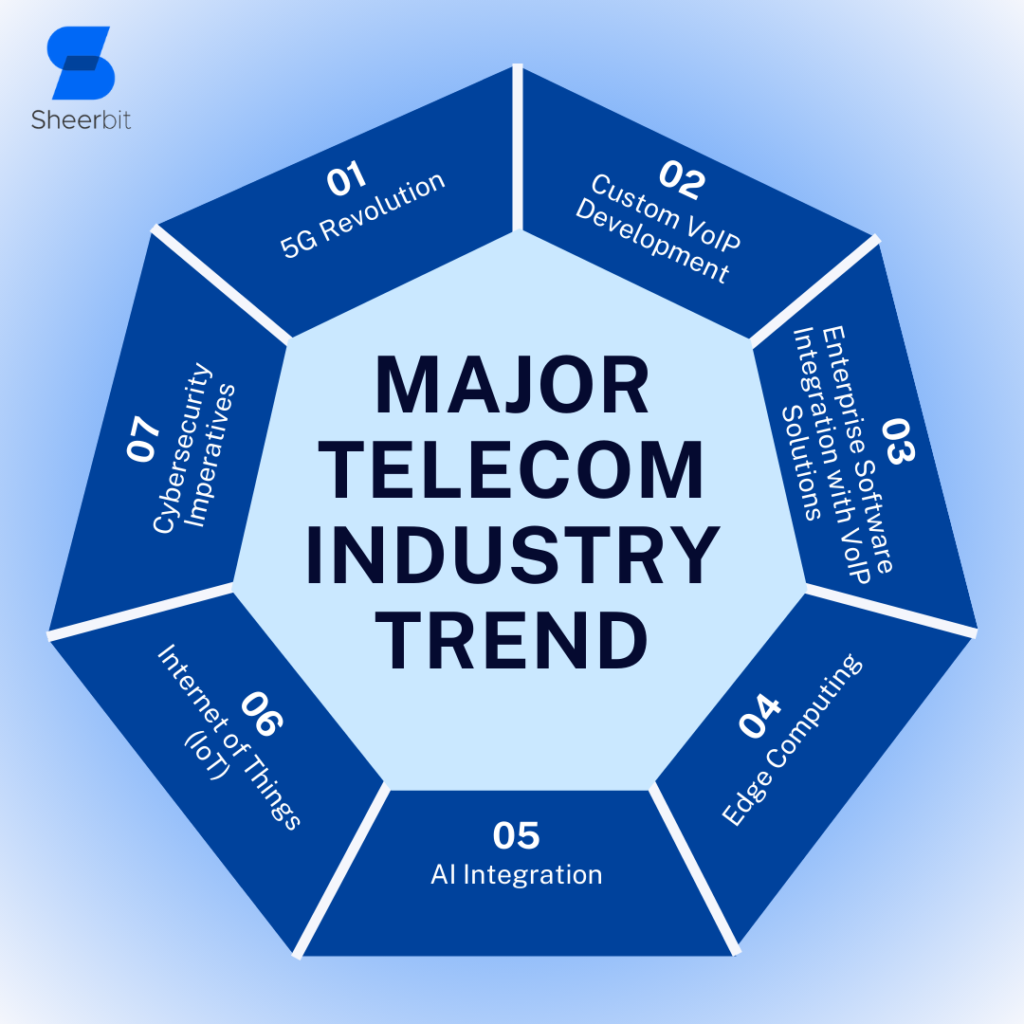Within the dynamic field of technology, the telecom industry is a constant source of change. Seldom do industries change so quickly, driven by breakthroughs that reshape our means of interaction, exchange, and cooperation. Telecom firms must take the lead in navigating the digital currents of 2024 and plan a route that embraces the future with agility and insight rather than just navigating these changes passively. During the ever-changing waves of development, telecom companies must not only identify the current situation but also predict the underlying currents of new trends so they can take an active role in determining the direction the industry takes. Together, let’s set out to investigate the dynamic currents and game-changing factors that shape the telecom scene in this historic year.
Telecom firms find themselves at a crossroads of innovation and adaptation as the technological horizon continues to grow, bringing both possibilities and problems. In addition to being resilient to change, people in the digital era must also take the initiative to welcome it. In 2024, telecom companies will succeed if they can ride the waves of change and adjust their strategies to stay ahead of the curve, anticipate client wants, and strengthen their positions in a cutthroat market.

Major Telecom Industry Trend
1. 5G Revolution:
After much anticipation, 5G has finally arrived, bringing with it a new age of connectedness. With its extremely low latency, enormous capacity, and lightning-fast speeds, 5G is poised to completely transform how industries function and people communicate. To build out 5G networks, telecom firms are massively investing in infrastructure, opening the door for technologies like augmented reality, driverless cars, and the Internet of Things.
2. Custom VoIP Development:
VoIP (voice over internet protocol) technology is still gaining popularity since it provides feature-rich and affordable communication options. We predict a sharp increase in bespoke VoIP development in 2024, catering to the unique requirements of commercial clients. Telecom carriers are improving VoIP services with cutting-edge features like AI-powered voice assistants, virtual receptionists, and video conferencing.
3. Enterprise Software Integration with VoIP Solutions:
Demand for seamless integration with enterprise software systems is rising as VoIP becomes the primary means of communication for enterprises. To connect VoIP solutions with project management software, CRM systems, and other critical business applications, telecom providers are working with software developers. Thanks to this connection, enterprises benefit from a unified communication experience, improved productivity, and streamlined workflows.
4. Edge Computing:
The latency and capacity of traditional cloud computing infrastructure are becoming increasingly limited due to the exponential growth of data created. With edge computing, processing power may now be found closer to the source of data. To provide real-time data processing and analysis, the Telecom Industry is leading the way in the deployment of edge computing nodes. Applications like smart cities and industrial automation that need to make decisions instantly can benefit significantly from this distributed design.
5. AI Integration:
Artificial intelligence (AI) is changing the telecom environment in the present and is no longer a future notion. Artificial intelligence algorithms are being incorporated into many facets of telecom operations, ranging from personalized customer experiences to predictive maintenance. Telecom Industry may improve cybersecurity, automate procedures, and optimize network performance by leveraging AI’s capabilities.
6. Internet of Things (IoT):
IoT device growth is continuing unabated, which is driving the need for effective data management and seamless communication. Telecom companies are reaching out to a wide range of industries, from agriculture to healthcare, by growing their IoT solutions. The introduction of 5G is expected to accelerate the adoption of IoT and open up new applications like wearables, smart grids, and smart homes.
7. Cybersecurity Imperatives:
Growing digitalization raises cybersecurity risks. To protect their networks, data, and customers’ privacy, telecom firms are strengthening their cybersecurity protocols. Cybersecurity continues to be a primary concern for all parties involved in the telecom sector, from implementing strong encryption methods to introducing AI-driven threat detection systems.
Essential Insights into Current Trends
1. Align with Technology:
Accept new technological developments and ensure your products are always at the cutting edge of the market. Use data analytics to spot new trends and modify your approach accordingly.
2. Stay Ready for Change:
Be flexible and agile, prepared to change course as the market and your customers’ demands do. Create an innovative culture in your company by motivating staff members to try out new concepts and cutting-edge tools.
3. Make Conversant Decisions:
Make well-informed judgments by utilizing data-driven insights to remain ahead of the curve and predict market trends. Invest in systems and tools for analytics that let you collect, evaluate, and act on data instantly.
4. Gain a Competitive Advantage:
Make a name for yourself by providing excellent customer service, innovative ideas, and remaining one step ahead of the competition. To continuously improve your goods and services, make research and development investments. It would help if you also worked with industry partners to make use of complementary resources and experience.
Significant Challenges in the Implementation of the Latest Trends
1. Infrastructure Investment:
The implementation of modern technologies such as 5G and edge computing requires a large infrastructure investment. Budgets may be strained, and implementation may be slowed down by the substantial financial and resource commitment required to build and upgrade the networks that enable these technologies.
2. Regulatory Compliance:
The environment in which telecom businesses operate is highly regulated, with rules and regulations controlling everything from data protection to spectrum allocation. Complying with compliance standards when implementing new technology can be difficult and time-consuming; careful preparation and collaboration with regulatory organizations are necessary.
3. Interoperability Challenges:
Integrating new technologies with current platforms and systems can be challenging, mainly when compatibility problems occur. Considerable testing, troubleshooting, and customization are sometimes necessary to ensure flawless compatibility across various components and providers, which complicates implementation processes.
4. Cybersecurity Risks:
The development of digital services and linked devices has led to an increase in the sophistication and prevalence of cybersecurity threats. Robust cybersecurity safeguards are crucial to safeguard networks, data, and consumer privacy; nevertheless, doing so calls for constant investment in security infrastructure, staff development, and risk reduction techniques.
5. Skill Shortages:
The need for qualified workers with experience in fields like artificial intelligence (AI), edge computing, and cybersecurity is rising due to the rapid evolution of technology. Nevertheless, talent scarcity exists in these specialized domains, which makes it difficult for businesses to find and hire people with the necessary skills for managing and deploying new technology.
6. User Acceptance and Adoption:
Users may be resistant to change or skeptical about new technology, especially if they believe the changes are unneeded or disruptive. Effective training, support systems, and communication are necessary to guarantee user acceptance and adoption and educate users about the new technology’s advantages and potential.
7. Legacy System Integration:
Many telecom firms continue to use antiquated infrastructure and systems, which may make it difficult to integrate with contemporary technologies. Integrating new systems with old infrastructure can be difficult and expensive; thorough planning and perhaps staged migration procedures are needed to reduce operational interruptions.
One thing is certain as we manage these revolutionary trends: flexibility is critical. To prosper in this changing environment, telecom firms need to embrace agility, innovation, and teamwork. By remaining aware of their customers’ requirements and the latest technology developments, companies may surf the tides of change and emerge more vital than ever.
Come along with us as we embrace the telecom of the future. With our state-of-the-art solutions customized to your connection requirements, you can stay ahead of the curve. Contact us right now to start your road towards digital transformation and smooth communication.





